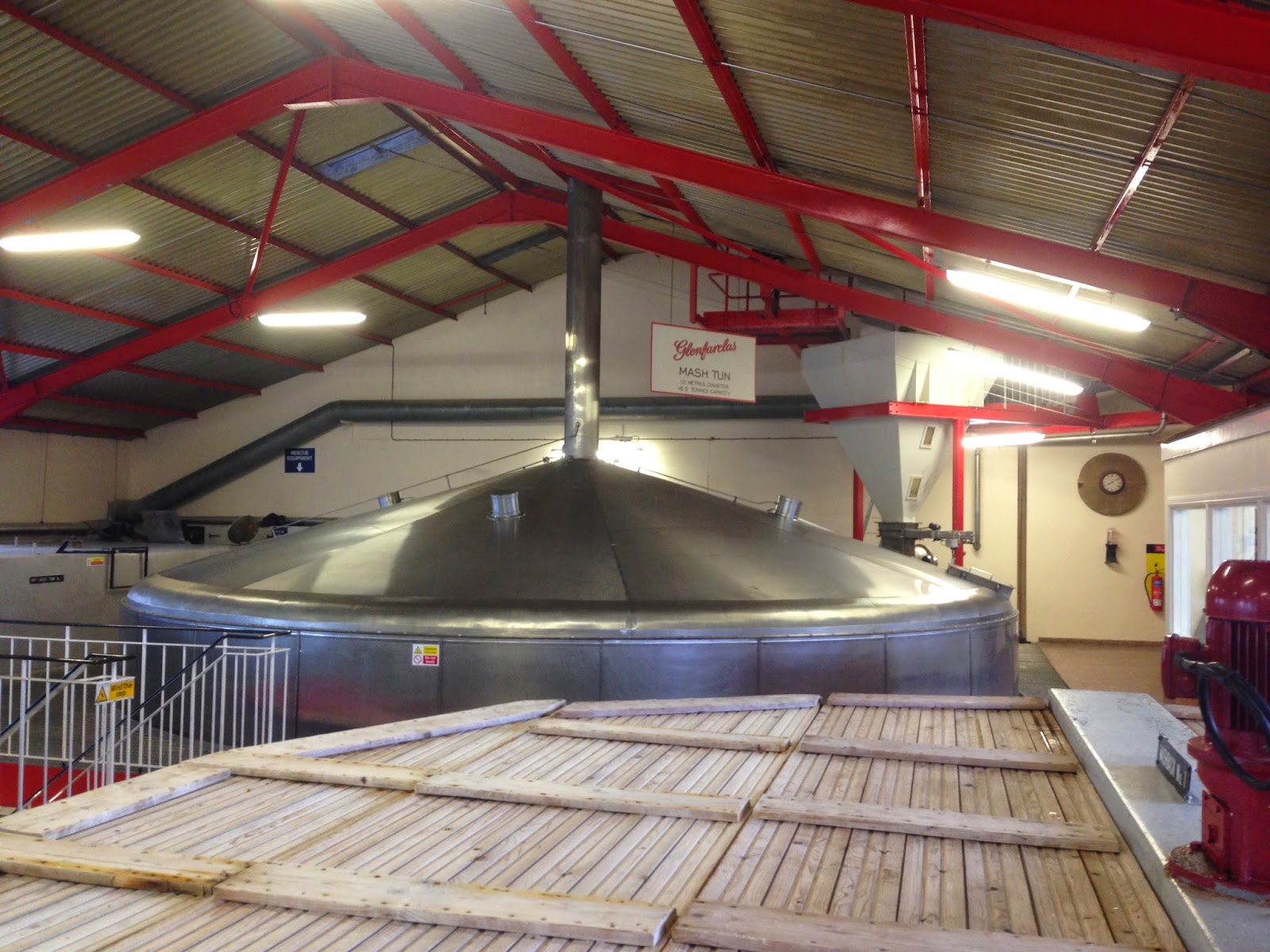- Obtain malted barley (barley that has been allowed to germinate, then toasted to stop the germination process).
- Grind it up to release the sugars.
- Add this, with hot water and liquid yeast, to the mash tun. The mash tun is essentially a 60-something-thousand litre teapot. The ground malted barley (referred to as "malt") steeps in this water , then all the water is slowly drained off into a wash back with some yeast. A wash back is the fermentation tank.
- More hot water (known as the 2nd water) is added to the malt, much like getting a second brew out of your tea bag, and this water is also drained into the wash back. Before it has fermented, this liquid is referred to as "wort". The lid is shut on the wash back and the wort is left to ferment until most of the sugars have been turned to alcohol. This takes roughly 48 hours.
- A 3rd water is pumped onto the malt, then pumped back into a holding tank. This will be used as the 1st water for the next brew(!). The leftover spent grain is known as draff. This is pushed out of the mash tun by mechanical arms and augers. It gets taken away by truck and turned into animal feed.
- After fermentation, you are left with what is essentially a weak, un-hopped beer, still full of half-dead yeasts. On my first day at Glenfarclas, the Production Manager, Callum said to me "You can drink this. You can get drunk on it, but it WILL put you on the toilet for 2 days".
- That beer, known as "wash" is then pumped to the distillation area to be refined into spirit and put into casks (more on this in another post).
The Mashman has a computer screen that allows him to open and close a number of pneumatic valves to shift liquid around. He can see how much liquid has gone to where, what temperature it is and how long it has been there for. In addition to the pneumatic valves, there are plenty of manually operated valves. He is constantly checking the position of valves and the open drain channels to make sure precious liquid is not being sent to the wrong place, or down the drain. All the vessels have to be regularly pressure-hosed, then treated with bleach and hot steam to kill any bugs that could interfere with the next brew.
Mashing and distilling at Glenfarclas is a 24-hour operation, Monday to Friday. The Mashman works an 8-hour shift. In my first week of training, I was working with James on the 6am to 2pm shift. James has worked in whisky production at several distilleries in the area for 30 years, not that you would think it possible to look at him. On my first day, James explained to me he is essentially lazy, so sitting behind a computer, controlling the process suits him nicely. James's definition of lazy clearly differs from mine. He starts the shift at full-speed, checking that all the processes that were started in the previous shift are running as they should be and assesses what he will need to do over the next 8 hours. He goes and talks to the still operator to check that the distillation is running to schedule and establishes when he will need the next batch of wash for distilling.
 |
| Good loons: James the Mashman and John the Stillman (not a couple) |
Whenever James instructs the computer to shift some liquid or malt around, he gets up and goes to check that it is happening and that there are no blockages or valves left in the wrong position. He is always thinking one step ahead, or doing something now, so it will help with the process later on in the day. He is constantly listening for noises that could indicate a problem, a pump running dry or a process ending. Meanwhile, he is managing the malt milling process for the next batch.
After doing this for a couple of hours, he can stop for a couple of minutes and enjoy a cup of tea (while still keeping a close eye and ear on everything). At any time, a truck could show up with a load of malt or to take away the draff, requiring him to co-ordinate the process. I think I could teach him a thing or two about lazy.
At the end of each week, the Mashman who is working on a Friday afternoon thoroughly cleans out the mash tun so it's ready to go when shifts start again the following Sunday night. Cleanliness is paramount to prevent an infection that could affect fermentation and write-off days worth of production and thousands of pounds in raw materials.
 |
| Matthew IN the mash tun |
 |
| Glenfarclas has the largest mash tun in Scotland, at 10 metres in diameter. |
 |
| The 12 wash backs. This is the upper storey of a two-storey building and the washbacks go almost to the ground, holding around 27,000 litres each. |
When not making whisky or sleeping, I've been exploring the area, visiting to the nearby towns and villages and doing lots of country walks. It feels very much like spring is here. The first bulbs are flowering, the days are getting longer. The squirrels, foxes and badgers will soon be snufflling around. I sometimes think I'm living in a mixture of Wind in the Willows and Monarch of the Glen.
I don't think I could be any happier.








